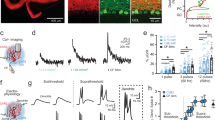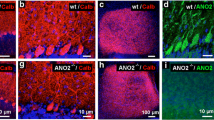Abstract
Cerebellar plasticity is often investigated using brief electrical coactivation of climbing and parallel fiber pathways to evoke Long Term Depression (LTD), a temporary decrease in the excitability of Purkinje cell Simple Spikes (SSs). The mechanistic importance of individual proteins in climbing fiber-evoked depression of simple spikes can be approached by examining the longer-term role of regulated microRNA transcription. In this review, we examine the consequences of longer activation (1–30 h) of climbing fibers on the expression of microRNAs, mRNAs and proteins in targeted Purkinje cells of the mouse. Horizontal optokinetic stimulation (HOKS) of unanesthetized mice increases climbing fiber discharge of floccular Purkinje cells ipsilateral to the stimulated eye. This increased climbing fiber discharge increases the expression of several microRNA and mRNA transcripts. One of these transcripts, miR335, increases 18X after 24 h of HOKS. Pri-miR335 transcripts increase 28X after 24 h of HOKS. miR335 transcripts decay with a time constant of ~2.5 h. Increases in miR335 transcripts are coupled with decreases in the expression of calbindin, 14-3-3-θ and protein kinase C-γ (PKC-ɣ). This interaction is critical for the serine phosphorylation of the GABAA-ɣ2 receptor and its membrane expression in Purkinje cells and may contribute to homeostatic regulation of Purkinje cell discharge of SSs.
Access this chapter
Tax calculation will be finalised at checkout
Purchases are for personal use only
Similar content being viewed by others
References
Alley K, Baker R, Simpson JI (1975) Afferents to the vestibulo-cerebellum and the origin of the visual climbing fibers in the rabbit. Brain Res 98:582–589
Alsharafi WA, **ao B, Abuhamed MM, Luo Z (2015) miRNAs: biological and clinical determinants in epilepsy. Front Mol Neurosci 8:59
Ambros V (2004) The functions of animal microRNAs. Nature 431:350–355
Barmack NH, Hess DT (1980) Multiple-unit activity evoked in dorsal cap of inferior olive of the rabbit by visual stimulation. J Neurophysiol 43:151–164
Barmack NH, Nelson BJ (1987) Influence of long-term optokinetic stimulation on eye movements of the rabbit. Brain Res 437:111–120
Barmack NH, Qian Z (2002) Activity-dependent expression of calbindin in rabbit floccular Purkinje cells modulated by optokinetic stimulation. Neuroscience 113:235–250
Barmack NH, Yakhnitsa V (2008) Functions of interneurons in mouse cerebellum. J Neurosci 28:1140–1152
Barmack NH, Qian Z, Yakhnitsa V (2010) Climbing fibers induce microRNA transcription in cerebellar Purkinje cells. Neuroscience 171:655–665
Barmack NH, Qian Z, Yakhnitsa V (2014) Long-term climbing fibre activity induces transcription of microRNAs in cerebellar Purkinje cells. Philos Trans R Soc Lond Ser B Biol Sci 369(1652):20130508
Barnes JA, Ebner BA, Duvick LA, Gao W, Chen G, Orr HT, Ebner TJ (2011) Abnormalities in the climbing fiber-Purkinje cell circuitry contribute to neuronal dysfunction in ATXN1 [82Q] mice. J Neurosci 31:12778–12789
Bartel DP (2004) MicroRNAs: genomics, biogenesis, mechanism, and function. Cell 116:281–297
Bilen J, Liu N, Burnett BG, Pittman RN, Bonini NM (2006) MicroRNA pathways modulate polyglutamine-induced neurodegeneration. Mol Cell 24:157–163
Bushati N, Cohen SM (2007) microRNA functions. Annu Rev Cell Dev Biol 23:175–205
Cai X, Hagedorn CH, Cullen BR (2004) Human microRNAs are processed from capped, polyadenylated transcripts that can also function as mRNAs. RNA 10:1957–1966
Cajal SR (1911) Histologie du système nerveux de l'homme et des vertebrés. Maloine, Paris
Crepel F (2009) Role of presynaptic kainate receptors at parallel fiber-Purkinje cell synapses in induction of cerebellar LTD: interplay with climbing fiber input. J Neurophysiol 102:965–973
Cullen BR (2004) Transcription and processing of human microRNA precursors. Mol Cell 16:861–865
De Zeeuw CI, Koekkoek SK (1997) Signal processing in the C2 module of the flocculus and its role in head movement control. Prog Brain Res 114:299–320
Eccles JC, Llinás R, Sasaki K (1965) The inhibitory interneurones within the cerebellar cortex. Exp Brain Res 1:1–16
Eccles JC, Llinás R, Sasaki K (1966a) The excitatory synaptic action of climbing fibers on the Purkinje cells of the cerebellum. J Physiol 182:268–296
Eccles JC, Llinás R, Sasaki K (1966b) The mossy fibre-granule cell relay of the cerebellum and its inhibitory control by Golgi cells. Exp Brain Res 1:82–101
Eccles JC, Ito M, Szentágothai J (1967) The cerebellum as a neuronal machine. Springer, New York
Eulalio A, Huntzinger E, Nishihara T, Rehwinkel J, Fauser M, Izaurralde E (2009) Deadenylation is a widespread effect of miRNA regulation. RNA 15:21–32
Fox CA, Barnard JW (1957) A quantitative study of the Purkinje cell dendritic branchlets and their relationship to afferent fibres. J Anat 91:299–313
Fox CA, Hillman DE, Siegesmund KA, Dutta CR (1967) The primate cerebellar cortex: a Golgi and electron microscopic study. In: Fox CA, Snider RS (eds) Progress in brain research, vol. 25: the cerebellum. Elsevier, New York, pp 174–225
Ghildiyal M, Zamore PD (2009) Small silencing RNAs: an expanding universe. Nat Rev Genet 10:94–108
Goossens J, Daniel H, Rancillac A, van der Steen J, Oberdick J, Crepel F, De Zeeuw CI, Frens MA (2001) Expression of protein kinase C inhibitor blocks cerebellar long-term depression without affecting Purkinje cell excitability in alert mice. J Neurosci 21:5813–5823
Goossens HH, Hoebeek FE, Van Alphen AM, van der Steen J, Stahl JS, De Zeeuw CI, Frens MA (2004) Simple spike and complex spike activity of floccular Purkinje cells during the optokinetic reflex in mice lacking cerebellar long-term depression. Eur J Neurosci 19:687–697
Granit R, Phillips CG (1956) Excitatory and inhibitory processes acting upon individual Purkinje cells of the cerebellum in cats. J Physiol 133:520–547
Guo H, Ingolia NT, Weissman JS, Bartel DP (2010) Mammalian microRNAs predominantly act to decrease target mRNA levels. Nature 466:835–840
Haramati S, Chapnik E, Sztainberg Y, Eilam R, Zwang R, Gershoni N, McGlinn E, Heiser PW, Wills AM, Wirguin I, Rubin LL, Misawa H, Tabin CJ, Brown R Jr, Chen A, Hornstein E (2010) miRNA malfunction causes spinal motor neuron disease. Proc Natl Acad Sci U S A 107:13111–13116
Harfe BD (2005) MicroRNAs in vertebrate development. Curr Opin Genet Dev 15:410–415
Harvey RJ, Napper RM (1991) Quantitative studies on the mammalian cerebellum. Prog Neurobiol 36:437–463
Hayes J, Peruzzi PP, Lawler S (2014) MicroRNAs in cancer: biomarkers, functions and therapy. Trends Mol Med 20:460–469
Hobert O (2008) Gene regulation by transcription factors and microRNAs. Science 319:1785–1786
Ito M, Sakurai M, Tongroach P (1982) Climbing fibre induced depression on both mossy fibre responsiveness and glutamate sensitivity of cerebellar Purkinje cells. J Physiol 324:113–134
Johnston M, Hutvagner G (2011) Posttranslational modification of Argonautes and their role in small RNA-mediated gene regulation. Silence 2:5
Konnerth A, Llano I, Armstrong CM (1990) Synaptic currents in cerebellar Purkinje cells. Proc Natl Acad Sci U S A 87:2662–2665
Konopka W, Schütz G, Kaczmarek L (2011) The microRNA contribution to learning and memory. Neuroscientist 17:468–474
Kosik KS (2006) The neuronal microRNA system. Nat Rev Neurosci 7:911–920
Landgraf P et al (2007) A mammalian microRNA expression atlas based on small RNA library sequencing. Cell 129:1401–1414
Lee Y, Ahn C, Han J, Choi H, Kim J, Yim J, Lee J, Provost P, Radmark O, Kim S, Kim VN (2003) The nuclear RNase III Drosha initiates microRNA processing. Nature 425:415–419
Leonard CS, Simpson JI, Graf W (1988) Spatial organization of visual messages of the rabbit’s cerebellar flocculus. I. Typology of inferior olive neurons of the dorsal cap of Kooy. J Neurophysiol 60:2073–2090
Linden DJ, Connor JA (2001) Long-term synaptic depression. Annu Rev Neurosci 18:319–357
Lund E, Dahlberg JE (2006) Substrate selectivity of exportin 5 and dicer in the biogenesis of microRNAs. Cold Spring Harb Symp Quant Biol 71:59–66
Maekawa K, Simpson JI (1973) Climbing fiber responses evoked in vestibulocerebellum of rabbit from visual system. J Neurophysiol 36:649–666
Maekawa K, Takeda T (1976) Electrophysiological identification of the climbing and mossy fiber pathways from the rabbit’s retina to the contralateral cerebellar flocculus. Brain Res 109:169–174
Mellios N, Sugihara H, Castro J, Banerjee A, Le C, Kumar A, Crawford B, Strathmann J, Tropea D, Levine SS, Edbauer D, Sur M (2011) miR-132, an experience-dependent microRNA, is essential for visual cortex plasticity. Nat Neurosci 14:1240–1242
Narasimhan K, Linden DJ (1996) Defining a minimal computational unit for cerebellar long-term depression. Neuron 17:333–341
O'Brien J, Hayder H, Zayed Y, Peng C (2018) Overview of microRNA biogenesis, mechanisms of actions, and circulation. Front Endocrinol (Lausanne) 9:402
Oyster CW, Simpson JI, Takahashi ES, Soodak RE (1980) Retinal ganglion cells projecting to the rabbit accessory optic system. J Comp Neurol 190:49–61
Pettorossi VE, Errico P, Ferraresi A, Barmack NH (1999) Optokinetic and vestibular stimulation determines the spatial orientation of negative optokinetic afternystagmus in the rabbit. J Neurosci 19:1524–1531
Qian Z, Micorescu M, Yakhnitsa V, Barmack NH (2012) Climbing fiber activity reduces 14-3-3-θ regulated GABAA receptor phosphorylation in cerebellar Purkinje cells. Neuroscience 201:34–45
Reinhart BJ, Slack FJ, Basson M, Pasquinelli AE, Bettinger JC, Rougvie AE, Horvitz HR, Ruvkun G (2000) The 21-nucleotide let-7 RNA regulates developmental timing in Caenorhabditis elegans. Nature 403:901–906
Robins H, Press WH (2005) Human microRNAs target a functionally distinct population of genes with AT-rich 3′ UTRs. Proc Natl Acad Sci U S A 102:15557–15562
Sakurai M (1987) Synaptic modification of parallel fibre-Purkinje cell transmission in in vitro guinea-pig cerebellar slices. J Physiol 394:463–480
Sanes JR, Lichtman JW (1999) Can molecules explain long-term potentiation? Nat Neurosci 2:597–604
Saurin AT, Durgan J, Cameron AJ, Faisal A, Marber MS, Parker PJ (2008) The regulated assembly of a PKCepsilon complex controls the completion of cytokinesis. Nat Cell Biol 10:891–901
Schaefer A, O'Carroll D, Tan CL, Hillman D, Sugimori M, Llinas R, Greengard P (2007) Cerebellar neurodegeneration in the absence of microRNAs. J Exp Med 204:1553–1558
Schonewille M, Luo C, Ruigrok TJ, Voogd J, Schmolesky MT, Rutteman M, Hoebeek FE, De Jeu MT, De Zeeuw CI (2006) Zonal organization of the mouse flocculus: physiology, input, and output. J Comp Neurol 497:670–682
Schonewille M, Gao Z, Boele HJ, Veloz MF, Amerika WE, Simek AA, De Jeu MT, Steinberg JP, Takamiya K, Hoebeek FE, Linden DJ, Huganir RL, De Zeeuw CI (2011) Reevaluating the role of LTD in cerebellar motor learning. Neuron 70:43–50
Schratt G (2009) microRNAs at the synapse. Nat Rev Neurosci 10:842–849
Schratt GM, Tuebing F, Nigh EA, Kane CG, Sabatini ME, Kiebler M, Greenberg ME (2006) A brain-specific microRNA regulates dendritic spine development. Nature 439:283–289
Simpson JI, Alley KE (1974) Visual climbing fiber input to rabbit vestibulocerebellum: a source of direction-specific information. Brain Res 82:302–308
Simpson JI, Leonard CS, Soodak RE (1988) The accessory optic-system. Analyzer of self-motion. Ann N Y Acad Sci 545:170–179
Smalheiser NR, Lugli G (2009) microRNA regulation of synaptic plasticity. Neuromol Med 11:133–140
Tognini P, Putignano E, Coatti A, Pizzorusso T (2011) Experience-dependent expression of miR-132 regulates ocular dominance plasticity. Nat Neurosci 14:1237–1239
Yakhnitsa V, Barmack NH (2006) Antiphasic Purkinje cell responses in mouse uvula-nodulus are sensitive to static roll-tilt and topographically organized. Neuroscience 143:615–626
Zeng Y, Cai X, Cullen BR (2005) Use of RNA polymerase II to transcribe artificial microRNAs. Methods Enzymol 392:371–380
Author information
Authors and Affiliations
Corresponding author
Editor information
Editors and Affiliations
Rights and permissions
Copyright information
© 2023 The Author(s), under exclusive license to Springer Nature Switzerland AG
About this chapter
Cite this chapter
Barmack, N.H. (2023). Cerebellar Epigenetics: Transcription of microRNAs in Purkinje Neurons as an Approach to Neuronal Plasticity. In: Gruol, D.L., Koibuchi, N., Manto, M., Molinari, M., Schmahmann, J.D., Shen, Y. (eds) Essentials of Cerebellum and Cerebellar Disorders. Springer, Cham. https://doi.org/10.1007/978-3-031-15070-8_19
Download citation
DOI: https://doi.org/10.1007/978-3-031-15070-8_19
Published:
Publisher Name: Springer, Cham
Print ISBN: 978-3-031-15069-2
Online ISBN: 978-3-031-15070-8
eBook Packages: Biomedical and Life SciencesBiomedical and Life Sciences (R0)




